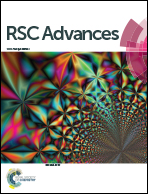CdS/CdSe co-sensitized hierarchical TiO2 nanofiber/ZnO nanosheet heterojunction photoanode for quantum dot-sensitized solar cells†
Abstract
In this manuscript, a novel hierarchical ZnO nanosheets branched electrospun TiO2 non-woven fabric film is prepared and used as a photoanode for quantum dot-sensitized solar cells (QDSSCs). Porous ZnO nanosheets grown on a TiO2 nanofiber are synthesized via simple hydrothermal reaction followed by a calcination process, which is proven to provide both large surface areas for QDs loading and superior light-scattering capability. Detailed photoelectrochemical measurements, including UV-vis diffuse reflectance and absorption spectra, electrochemical impedance spectra (EIS), intensity-modulated photocurrent/photovoltage spectroscopy (IMPS/IMVS), etc., reveal that, compared with a bare TiO2 nanofiber film, the hierarchical fibrous film exhibits enhanced light-harvesting efficiency, suppressed electron recombination and superior charge-collection efficiency, thus leading to both improved short-circuit current density (Jsc) and open-circuit voltage (Voc). Therefore, the conversion efficiency of the solar cell is greatly improved from 2.37% for a bare TiO2 nanofiber film to 3.05%. A Cu2S counter electrode can help to yield a conversion efficiency as high as 4.21%.



 Please wait while we load your content...
Please wait while we load your content...